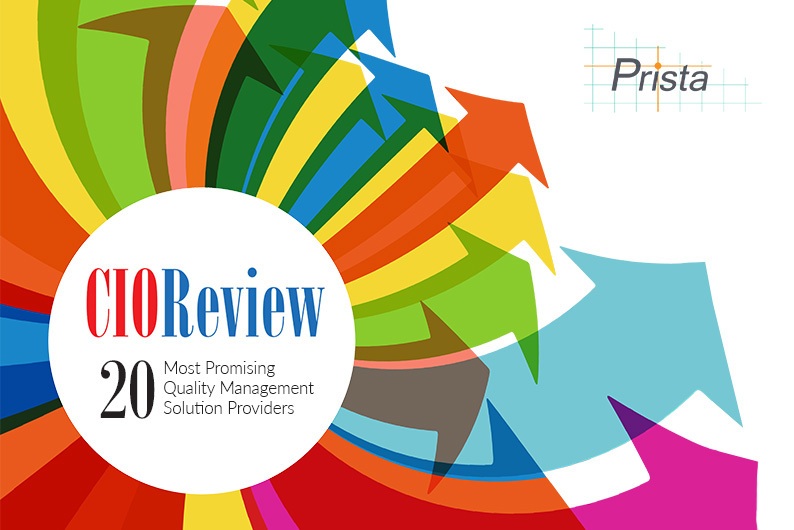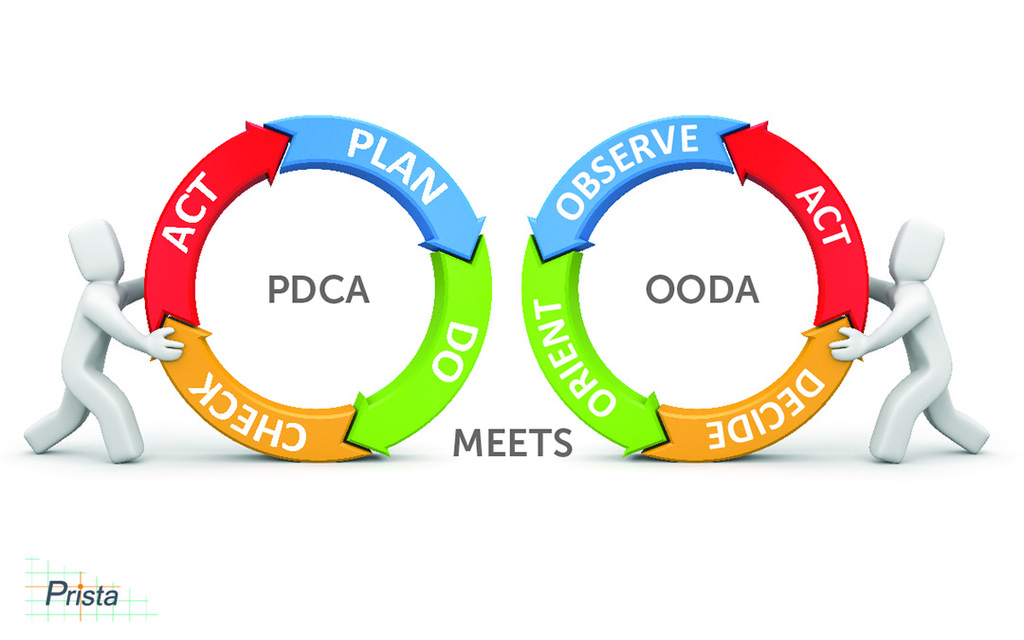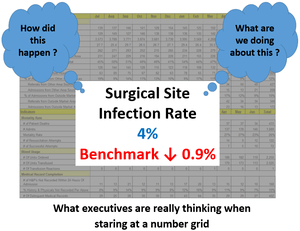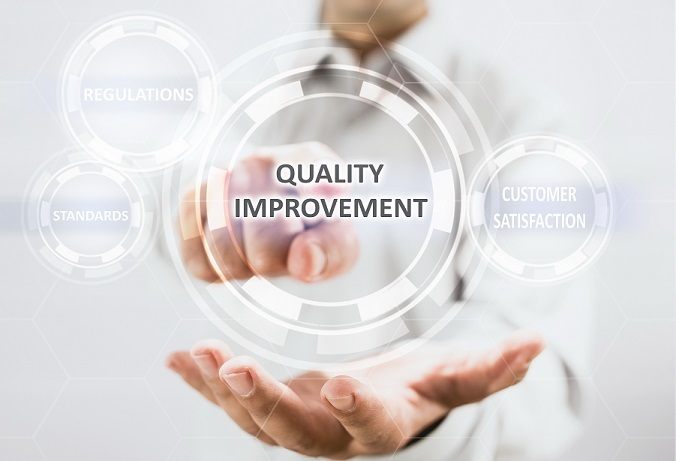
Prista Named One of 2017’s Most Promising Quality Management Solution Providers
CIOReview recently recognized Prista Corporation as one of 2017’s “20 Most Promising Quality Management Solution Providers,” and we’re proud to have been recognized as a company that has demonstrated an exceptional ability to innovate and customize a solution that meets our clients’ quality management needs.
The December issue of CIOReview is centered around the idea that quality management is no longer a nice-to-have addition, but an aspect that is imperative for businesses to survive in the current competitive landscape. While this is certainly true, we believe when it comes to healthcare IT, a successful tool must enable quality management, safety event reporting and performance improvement teams to work collaboratively and efficiently, eliminating inconsistent, disorganized information, and facilitating effective improvement powered by real-time insights. Our mission to provide a tool that’s simple, collaborative and insightful was the driving force behind the development of the ActionCue CI application.
According to the magazine, ActionCue CI has changed the way hospitals manage risk, quality, and performance improvement by making information easy to access and understand. Our quality management clients appreciate ActionCue’s ability to provide insights, rather than numbers, through detailed reports that highlight the “big picture.” They can view reports and track data and trends in real-time, without ever touching a spreadsheet. With the ability to quickly investigate causes and manage corrective actions, our clients are able to take real steps toward improving patient care.
We’re delighted to have been recognized for our efforts in providing a solution that our clients truly value. If you’d like to learn more about ActionCue CI and why our innovation and commitment to increasing patient care quality is fostering a new “Culture of Quality” within the healthcare industry, check out some of our informational videos or read what our clients have to say about the tool.

Increasing Efficiency in 2018
It’s the beginning of a new year, and in 2018 the healthcare industry would greatly benefit from better utilization of resources. U.S. health care spending grew 4.3 percent in 2016, reaching $3.3 trillion, while an estimated $1 trillion is wasted each year on inefficiencies, redundancies and abuse. With an aging population, and chronic illnesses and obesity on the rise, emergency department staff will continue to be flooded with patients, while hospitals work to comply with new CMS mandates and rulings, and improve quality of patient care.
Hospitals are constantly working to increase productivity and reduce expenditures, while statistics continue to remind us that time is money. In 2017, EY conducted an advisory study of the healthcare industry, and after analyzing the data, suggested a holistic approach to reducing inefficiencies and improving quality of care. Of the five points presented, we’ll focus on the three areas where our ActionCue CI platform can make a significant impact for healthcare organizations in 2018: transforming the culture, advancing with analytic insights, and increasing productivity
Transforming the Culture
In 2017, we presented a four-part series on innovation and the role of leadership in creating action that improves patient safety and quality. A recurring theme in the series, and a concept we work to continuously promote, is creating a “culture of quality.” Improving culture is the first step towards improving patient safety and reducing inefficiency, and it must begin at the top. Organizational leadership must be deeply involved and aware of the challenges clinical staff face daily. Executive engagement is crucial to improving overall culture, but it’s no secret that executives face substantial time constraints. According to Becker’s Hospital Review, the average CEO spends about 2.5 hours per day in meetings, and 21.2% of a CEO’s solitary workday is devoted to reading and analyzing reports.
ActionCue CI allows staff to create comprehensive, easy-to-read reports in minutes, not days, providing real-time access to insights and performance measures while reducing time spent in meetings or analyzing confusing data sets. This creates more time for leadership to engage with clinical staff and take a more involved approach to culture. Because 51% of EY respondents believe employee satisfaction in healthcare drives patient satisfaction, not only will this boost morale, it will positively impact patient care.
Advancing with Analytic Insights
Access to reliable, accurate and insightful data is imperative as hospitals work to improve performance and quality. There’s more focus on patient outcomes than ever before, and as CMS continues to impose regulations and mandates, the spotlight is on hospitals to perform or risk losing funding. Executives need immediate access to meaningful metrics on safety events, corrective actions, performance indicators, quality management, risk management and more.
With event reporting, quality management and performance improvement tracking in one easy-to-use online platform, ActionCue CI is your Fast Path to Insight™. Its robust, real-time reporting features give executives the data they need to be proactive, rather than reactive, and drive better clinical outcomes.
Increasing Productivity
Organizations’ leaders have historically accepted that quality and safety efforts require a large amount of time and effort, and lengthy processes. However, we believe applications should focus on collaboration and workflows that not only match the natural tasks and processes of users, but also shape the users’ behavior by encouraging methodologies that produce targeted results, and increase efficiency and accountability.
ActionCue’s design goes beyond ease-of-use to advance the way in which healthcare organizations engage with information in an application. The platform proves to be an enjoyable working team member, increasing productivity and facilitating education and improvement towards goals. Executives hoping to cut costs in 2018 should place significant focus on improving productivity and efficiency. With low operation costs, no hardware or installation requirements, and month-to-month subscriptions, the impact of ActionCue CI on cost reductions is two-fold.
As the healthcare industry continues to place more emphasis on quality and performance improvement, and improved clinical outcomes, 2018 promises to be a year during which increased efficiency and better utilization of resources is a major focus, and rightly so. If you’d like to learn more about how ActionCue CI can help you reach your quality and performance improvement goals more efficiently, contact us today and start 2018 off on the right foot.

PDCA vs. OODA: Facilitating a More Effective Improvement Methodology
As we work to continually evolve Prista’s ActionCue Clinical Intelligence (CI) application as the leading performance improvement workbench in the healthcare market, we often dig into the essence and science of improvement itself. The ActionCue application not only embodies well-designed and powerful information processing, but also demonstrates an awareness of the principles and psychological aspects of improvement methodologies.
Since the application is designed around these fundamentals and not overtly focused on the mechanics of any particular methodology, ActionCue’s design can support a variety of improvement mentalities. One approach to improvement frequently used in circles outside healthcare is the “Observe, Orient, Decide, Act” (OODA) cycle illustrated above. Ultimately, OODA is comparable in process and effectiveness to the “Plan, Do, Check, Act” (PDCA) cycle, but is nuanced in ways that may be applicable and valuable for healthcare .
As widely understood and utilized as the PDCA cycle is, many people subliminally think of the cycle and its steps as always in process across a variety of projects or topics, which can help support continuous improvement. While such cycles are intended to be continuous, the application of PDCA often begins with a plan developed by trained experts, to study certain functions or performance measures, or experiment with a technique, practice or protocol. Unfortunately, time and resource constraints in healthcare quality and safety efforts frequently dictate that as one improvement plan is undertaken, another gets retired.
OODA begins when someone—in some cases an improvement specialist, but often an executive—observes something that needs to be improved. This makes the process seem more immediately reactive than PDCA, which explains the popularity of OODA in the military and construction industry, where unexpected challenges arise requiring critical and immediate attention. Although it’s helpful for those initiating any process to denote a starting point,

Consider an executive with responsibilities stretched across the entire organization. One of the biggest challenges for management and executives is shifting mental focus as different departments or activities require his or her attention. While some members of the clinical team or supervisory staff may easily engage with and understand a certain sets of metrics, collection of related safety events or performance improvement project, those who have to do more frequent and significant context shifting can benefit from additional explanation and illustration, and will often ask for the “big picture.”
ActionCue CI’s Performance Standard Dashboard presents that big picture, with easy-to-follow links to additional presentations of related data, information and insight. These data hierarchies are designed to match the cognitive pathways of a healthcare leader, providing what we like to call the Fast Path to Insight™. Gaining insight is a crucial part of the “Orient” step in OODA, and when done well and quickly, leads to more effective “Decide” and “Act” steps. An understanding of the executive mindset and management process, functional integration, easy-to-use navigation, intelligent design, and a foundation of analytics, all play a part in providing effective insight.
The design focused on cognitive pathways and support for OODA orientation are not just valuable for executives. All users of ActionCue CI, in a variety of roles and with differing responsibilities, enjoy enhanced efficiency and productivity in their work, largely due to integrating daily into intuitive workflows. This is applicable whether a user is oriented to the OODA or PDCA mindset. All users collaborate and engage with necessary information more easily and when using ActionCue CI, and that is a big win.

Quality Improvement Performance Indicators: Prioritizing Your Data
In a recent blog post, the Center for Improvement in Healthcare Quality shed some light on an area of concern for many hospitals: the prioritization of data collection within their QAPI program. Hospitals are constantly working to monitor, report on and improve patient safety and quality of care, many of them collecting data on hundreds of performance indicators, but it’s impossible to monitor every single area.
This is where prioritization of data collection comes into play. The Centers for Medicare and Medicaid Services expects hospitals to prioritize high-risk, high-volume or problem-prone areas, but unfortunately, the agency is not specific on what areas qualify as such. However, the CIHQ suggests prioritizing performance indicators that are frequently cited for not being incorporated into a hospital’s QAPI program, such as:
Medication Use
- Sterile Compounding and IV Admixture
- Management of Hazardous Medications
- Medication Administration Practices for High-Risk Meds
Infection Prevention & Control
- Sterilization of Instruments & Supplies
- High-Level Disinfection of Instruments & Supplies
- MDRO and Isolation Practice
- Disinfection and Cleaning of Dialysis Machines & Equipment
Physical Environment
- Environmental Controls of Sensitive Areas (Temperature, Humidity, Air Balance)
- Maintenance and Operation of Critical Medical and Utilities Equipment
- Life Safety System Testing and Maintenance
- Implementation of Interim Life Safety Measures
- Protection Against Radiation Hazards
Food & Nutritional Services
- Food Service Preparation, Storage, and Cleanliness
Clinical Services
- Ordering Restraint & Seclusion
- Monitoring of Patients in Restraint & Seclusion
- Administration of Blood & Blood Products
- Protection of Patients at Risk of Self-Harm
- Administration of Sedation / Anesthesia
- Surgical and Invasive Procedures
While we support CMS and CIHQ in urging focus on certain performance indicators when a limited number can be tracked and addressed, hospitals should be very careful about reducing the number of tracked indicators due to time and resource constraints, because that could potentially have a damaging effect on the organization. The motivation to do so is often present and understandable, when hospitals are utilizing inefficient and labor-intensive performance tracking processes and tools. This is precisely the fundamental issue that Prista’s ActionCue CI application was designed to address.
ActionCue CI is your Fast Path to Insight™, monitoring all 19 performance indicators listed above and more, right out of the box. Its intuitive online dashboards provide critical QI/PI information to those who need it, when they need it. With gains in efficiency and productivity from using ActionCue CI, staff can carry out the quality, safety and improvement activities of the hospital, and cover and drive improvement on a larger number of measures, reducing the chances of being blindsided by a clinical performance issue or a derogatory survey finding.
In addition to comprehensive and efficient data collection, ActionCue helps hospitals take real actions to improve patient care, allowing staff to quickly investigate event causes and manage corrective actions through electronic event reporting. Many hospitals see significant increases in staff participation, communication and cooperation.
While it’s certainly important to take all necessary steps to avoid a CMS citation, ActionCue helps hospitals take quality and performance improvement a step further by truly creating a “Culture of Quality,” representing a collective and sustained commitment by organizational leaders to emphasize safety every single day.

Is Your Quality-Safety System Really a Do-it-Yourself Project? Should it be?
We frequently describe ActionCue Clinical Intelligence as redefining and facilitating the management process for quality-safety improvement. Understanding that taking on quality-safety improvement can bring some apprehension, we want to make clear that we do this to bring a radical increase in efficiency to the process of improving patient care delivery for clinical staff, managers and executives.
Whether a facility or system’s solutions for quality and safety management, tracking, and reporting consists of paper and Excel spreadsheets, internally developed systems, or commercial applications, most of those scenarios have something in common: They require clinical management to spend a good bit of time on manual work. This can include:
- Researching required performance measure definitions and their application within the facility
- Setting the structure of criteria, measures, reports, graphs and notifications within the system
- Entering, manipulating and checking data multiple times as it moves from safety tools and organizations to the quality management arena, and on to the places, tools, and people involved in performance improvement and management information systems
- Creating and executing the mechanisms for communication and collaborating with various staff to carry out multiple fractured workflow processes
- Producing forms, diagrams and other artifacts, the primary purpose of which is to demonstrate adherence to the chosen process and methodology
- Using additional tools, systems or steps to produce static reports in a variety of formats for management review meetings
- Revising and re-doing much of the above repeatedly in response to changing external reporting requirements, additional or revised inquiries, recurring meetings, staff turnover, etc.
It should be noted that in many cases, a good bit of that manual work could be done by administrative workers but is too interwoven in the clinical and quality-safety work to hand it off without major disruption in productivity. In other cases, it requires the clinical professionals to develop skills in information technology and data manipulation that should arguably not be required of them. Both of these instances seriously dilute the application of their best skills, education and professional abilities to improving quality-safety.
Unfortunately, many clinical managers and their senior management accept this kind of manual effort, and the resources it consumes, as the norm for working in quality, safety and improvement. Some believe it is the only way for solutions to work exactly as they want. Even by turning to multiple commercial software vendors, much of this same function building is required as the vendor happily customizes their product and charges significantly for it both upfront and on a continuous basis, while tying up hospital staff in planning and reviewing the customization. After-sale charges can even become the vendor’s primary business model. At Epic Systems’ User Group Meeting in September of 2016, CEO Judy Faulkner said she identifies Epic as a programming shop. The company spends just over 50 percent of operating expenses on research and development each year. With that perspective, how likely is it that such a vendor is going to make the application itself match the needs of its users, or reduce the work of installation, amount of training needed, or degree to which the vendor’s billable time is needed for ongoing administration and updates?
Costs that may be dispersed into the operating budget are often “hidden,” but really add up when considering the Total Cost of Ownership (TCO) for the solution. Almost all of this fits into the “administrative overhead” component of healthcare costs, which is understood by most in the C-suite of hospitals today to be increasing disproportionately.
Once this “build our own” mentality sets in, inertia takes hold. It is common for quality and safety solution acquisitions to focus on one of these “toolkits,” or basic products needing customization that lasts months after purchase. Over time, the organization feels as if it has invested so much into their status quo solution that they certainly don’t want to make a substantial change and start the process all over again. This is especially true when it could impact the many overt work processes in which they have also invested time, money and training.
Many managers initiating searches for quality and safety management solutions may not realize that a well-designed “turnkey” application—embodying not only effective technology but also expertly-crafted healthcare operational design—can be configured in days, not months, to fit their organizations and operations, and similarly be reconfigured to match their evolving needs. While turnkey applications such as ActionCue may be uncommon in healthcare IT, distancing the organization from the practice of costly extensive internal or vendor-teamed software development is something companies in almost all other verticals have done over the years. Although this requires some adjustment in perspective when reviewing products designed for a large healthcare marketplace, the very common mentality of “doing what you’ve always done” is something healthcare providers can simply no longer afford.
